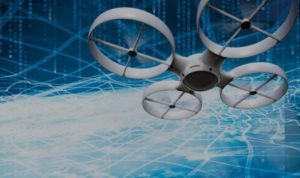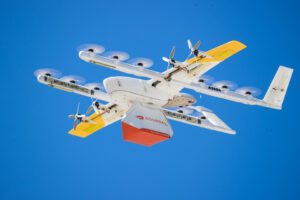 Unmanned Traffic Management (UTM) systems, commonly referred to as U-Space in Europe, are a critical piece of the ecosystem that will enable commercial drones and eVTOL to integrate safely and seamlessly with existing air traffic. UTM is not a single system: it’s a complex structure of regulations, technologies, and relationships working together to provide new levels of airspace awareness to all participants. At Amsterdam Drone Week today, a global group of stakeholders took the stage to discuss how UTM is being implemented in different regions.
Unmanned Traffic Management (UTM) systems, commonly referred to as U-Space in Europe, are a critical piece of the ecosystem that will enable commercial drones and eVTOL to integrate safely and seamlessly with existing air traffic. UTM is not a single system: it’s a complex structure of regulations, technologies, and relationships working together to provide new levels of airspace awareness to all participants. At Amsterdam Drone Week today, a global group of stakeholders took the stage to discuss how UTM is being implemented in different regions.
The panel included thought leaders in the space from around the globe: Jeffrey Vincent from the FAA, Huy Tran from NASA, Amit Ganjoo from ANRA Technologies, Stéphan Vaubourg of EASA, Amanda Boekholt from the Swiss Federal Office of Civil Aviation, Elwin van Beurden of the Dutch Ministry of Water and Transportation, and Matthew Satterly of global drone delivery provider Wing all took part in the session.
U-Space in Europe
U-Space is dedicated airspace for drones, making it easier for executing complex operations. EASA’s Vaubourg says that the key pillars of U-Space, the concept for UTM in the EU, are clear:
- To enable complex operations at scale;
- Safety: to provide the services, tactical information, and deconfliction tools to ensure safety;
- Harmonization: interoperability across European countries, and across the world.
The European Commission published rules for establishing U-Space in January of 2023. “The next steps will involve Member States designating their U-space areas and service providers as well as work on information exchange and navigation performance standards,” says the European Commission. “These technological developments will gradually support the full implementation of the U-space by 2030, as envisioned by the Drone Strategy 2.0.”
Developing U-Space areas is a complex process: and before U-Space was defined, some European regions took advantage of other available options to implement complex drone operations.
Elwin van Beurden leads the project at the Port of Rotterdam, which took the approach of identifying the Port of Rotterdam as a special geozone. Services at the Port of Rotterdam were driven by business – and expansion will happen naturally as more needs are identified, explained van Beurden. “It’s a very good strategy – it also shows that there is business for these services,” he points out.
 UTM Operational Key Site in Dallas, Texas
UTM Operational Key Site in Dallas, Texas
The FAA has taken a different approach, establishing a large site to evaluate complex commercial operations and utilize UTM components in Dallas, TX. The FAA’s Jeffrey Vincent says that the choice of the site was market driven: 5 major operators were all working in the area. The FAA determined that deconfliction technology was now at the point where it could be out in the field: 8 ecosystem participants, including drone service providers and UTM Service Providers (USPs) have agreed to share data and work towards interoperability.
The Key Site for operational evaluation is not a sandbox, it’s part of commercial operations. Participants have been granted permissions to operate and are working with real customers. “There is no end date. This is intended to be ongoing – we want to scale this and continue this.”
“You need to see the drones up in the air,” said Vincent. “We are learning so much right now by having those oerations work.”
“Dallas giving us real time information, real feedback to go into a rulemaking process. We hope that we’re going to get a rule on Day 1 that will be useful,” said Vincent.
NASA’s Huy Tran emphasizes that the Key Site is an industry-driven project. “We hope to get enough data from these operations to be able to start getting down the requirements,” she says.
The Intersection of European and US UTM
Global drone delivery player Wing and global UTM provider ANRA Technologies are working in both regions: both are working at the Texas Key Site, and both are working on European U-Space projects. These commercial companies are serving as a concrete bridge between concepts.
“Harmonization means establishing systems that are economically viable and technically sustainable to implement at scale, globally,” says Amit Ganjoo, Founder and CEO of ANRA. “Companies like us don’t want to develop separate technologies. We are using the exact same stack – we are synergizing across two regions.”
Wing’s Matthew Satterly agrees, pointing out that agencies like the Global UTM Association (GUTMA) are actively working on the problem of harmonization. “GUTMA provides a comprehensive north star on how we are able to meet the requirements of different regions under the same technology stack,” he said.
“There are 2 different approaches and we’re finding our way to the middle of both. For us, it’s really exciting.”
As UTM and U-Space continue to evolve, Ganjoo says that countries should utilize the data from all projects to inform development. Satterly concurs: “Dallas is providing evidence that UTM services are working as they should,” he says.
Read more:
- Terra Drone’s Unifly and SkeyDrone Enhance UTM System in Antwerp-Bruges Port Area
- ANRA Technologies Upgrades U-Space Services with New Simulation Features
- ANRA Technologies Forms Partnership with Estonian Aviation Academy to Launch U-space Test Center in Estonia
- Alphabet’s Wing Soars to New Heights: Larger Drone for Bigger Deliveries Announced

Miriam McNabb is the Editor-in-Chief of DRONELIFE and CEO of JobForDrones, a professional drone services marketplace, and a fascinated observer of the emerging drone industry and the regulatory environment for drones. Miriam has penned over 3,000 articles focused on the commercial drone space and is an international speaker and recognized figure in the industry. Miriam has a degree from the University of Chicago and over 20 years of experience in high tech sales and marketing for new technologies.
For drone industry consulting or writing, Email Miriam.
TWITTER:@spaldingbarker
Subscribe to DroneLife here.







[…] to new tech and a push for global rules. By 2030, Europe aims to fully apply the U-Space rules3. This is part of their Drone Strategy to handle many drones safely and […]